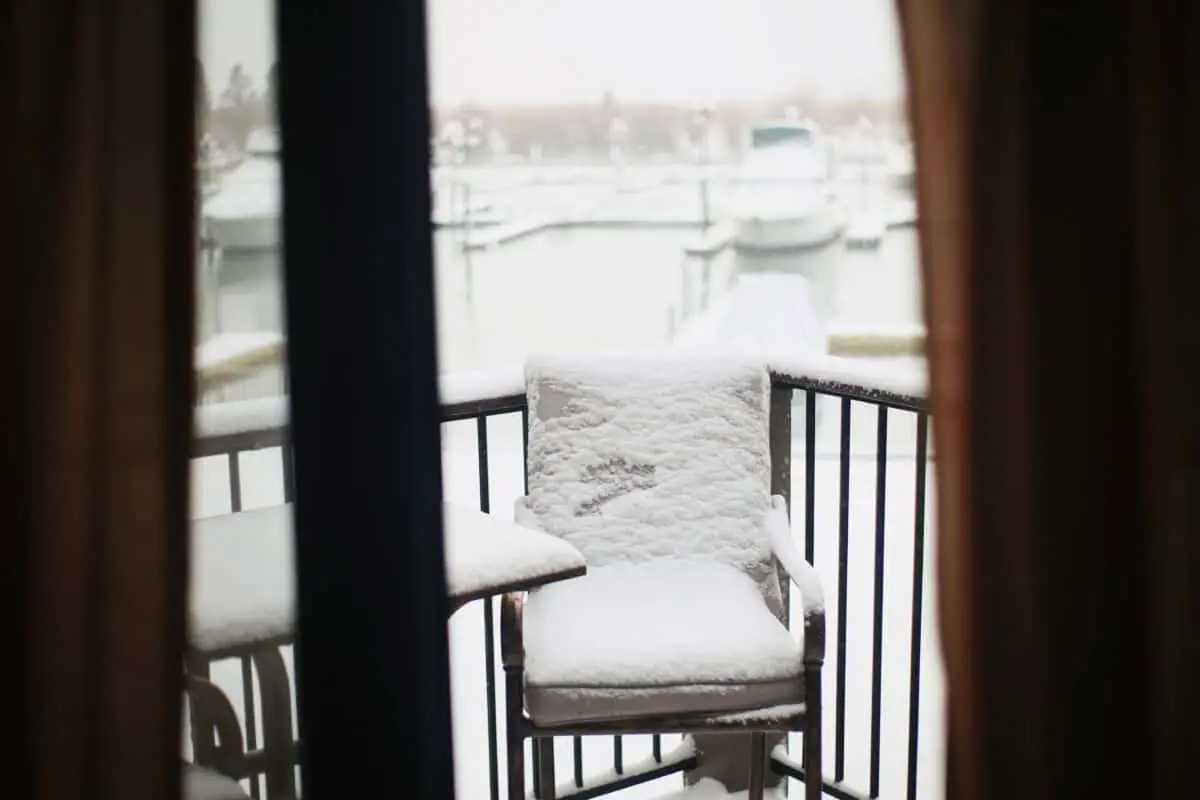Though they typically take less space than patios, balconies are considered by many as ‘floating patios.’ Unfortunately, for all their usability and aesthetic benefits, these multi-functional floating spaces are still significantly affected by the winter season, which usually renders them unusable. On a positive note, certain workarounds do exist to help you reclaim your balcony in winter.
To keep a balcony warm in the winter, you’ll need to choose whether to keep it open or closed, once you choose to enclose it, you can then glaze your balcony traditionally or with a heat insulated glazing system, and add a space heater, an electric fireplace or floor heating for extra warmth.
Getting cooped up in the house during winter is not ideal, and balconies are still livable spaces for most people as they offer a decent change of environment. So, if you’re looking for ways to make the most of this floating space despite the chilly climate, keep reading. In this article, we shall explore nine simple steps you can take to keep your balcony warm in winter.
Decide Whether to Keep It Open or Closed
The first decision you’ll have to make is whether to keep the balcony closed or open. This decision will affect the subsequent steps you’ll take to keep your balcony warmer in the winter. So, weighing the pros and cons of each option will come in handy.
For example, closed balconies attract less dust in contrast to the open ones and tend to keep temperatures relatively warmer. Though they inadvertently limit ventilation, this can be handled with different slider mechanisms, as we shall see. For other individuals, stoves can be utilized to heat balconies on a budget; however, this might not be advised in closed spaces.
Enclose Your Balcony
Generally, once you choose to enclose or shield your balcony from the cold, you can either utilize a sheet or insulated drape.
All things considered, there is an array of different balcony enclosure alternatives and materials that you can procure for this task, from heavy plastic, plexiglass, clear PVC tarps to outdoor waterproof curtains like this NICETOWN Outdoor Patio Curtains.
Furthermore, you can also utilize greenhouse plastic sheets, which can be combined with fiber reinforcement to add wind resistance. However, it is crucial to make sure that your intended adjustments are approved by your landlord, adhere to your city building restrictions, or adhere to the recommended building code standards for renovation.
READ ALSO: How to Know if You Can Enclose Your Balcony
Glaze Your Balcony
The second step will be to glaze your balcony. It is important to choose a befitting method of glazing – whether cold or warm.
In essence, cold glazing involves using a single layer of glass and lightweight frame. This technique avails relative insulation as it does not hold much heat. So, it is not really recommendable.
Alternatively, warm glazing while a more difficult and more expensive endeavor offers better results. This method involves employing window frames with double seals and double-glazed windows. Consequently, providing the required ability to maintain an adequate room temperature on the balcony, even during the winter season.
It is worth noting that while fixed glazing may be the cheapest option and can achieve better thermal insulation during winter, with relatively little effort, it, unfortunately, cannot be opened. It offers little flexibility, limits ventilation, and is difficult to clean. So, the installation of a sliding glazing system is more commendable as they can adapt to respective environmental conditions.
Watch the video below to see how this works:
Install a Heat Insulated Glazing System
If your heat requirements are still lacking, then a heat-insulated balcony system may be the next solution. Such a system provides significantly more thermal insulation in comparison to other glazing systems. With its adaptability to different seasons, a heat-insulated folding system can be effective in the sun, rain, cold, and snow.
However, the caveat with such systems concerns their thermal insulation properties (Ug value). Principally, the Ug value of such a system should be as low as possible for better thermal insulation to be achieved with less heating necessary.
Introduce a Space Heater
Though keeping a balcony space warm in the winter months can be quite challenging, a good outdoor space heater might do the trick, especially if you spend a considerable amount of time on your balcony, it’s worth the investment.
For the most part, you may be wondering how effective this approach might be considering how exposed your balcony might be. Worry not, the idea is to mitigate the cold with some warmer airflow, which can be achieved with infrared heaters, which are more precise while directing heat. Such heaters leverage directional infrared technology, meaning they are intentional and target the heat to where it is intended to go.
However, electric space heaters commonly found in “strip” form might be the most practical for your ‘floating space.’ Their strip form makes them easy to install on a variety of surfaces, allowing for an even heat dispersion from the heater surface. Furthermore, wall-mounted space heaters radiate warmth while taking up very little space.
Install Radiant Heaters
Fundamentally, radiant heaters provide uniform and fast heat dissipation and can be installed at a balcony. However, they need to be structurally fixed and may take up more space than warranted, though they could be worth it as the warmth advantage they offer outweighs the space obstruction.
Add Floor Heating
If your warmth requirements are not yet satisfied, the next step could be installing floor heating. Floor heating systems can be integrated into a balcony space and will allow you to even sit and lie on the floor too. However, in comparison to other heating alternatives, the cost of floor heating (both installation and running) is quite hefty.
That said, floor heating can help prevent the accumulation of snow and ice over time. Though, as an alternative, you can try using radiant floor heating mats or cables which can be installed in concrete, beneath stones and pavers.
Install an Electric Fireplace
From an environmental perspective, an electric fireplace may be the most feasible option to warm your balcony during winter. The virtually nonexistent carbon emission, their elegant designs make them an attractive option to use in a closed balcony.
Furthermore, they don’t require any airflow, so you will not make it suffocated (though some modern electric fireplace alternatives now maintain an impressive wind resistance factor due to design improvements).
Electric fireplaces offer a great alternative to gas heaters and are usable for both indoor and outdoor spaces. Electric fireplaces are often less obtrusive than gas options, yet still provide the same gentle warmth at minimal operating costs as they’re more affordable to run, depending on energy prices in your vicinity.
Use Portable and Tabletop Heaters
Ultimately, the last step to keep your balcony warm in winter will be to use portable or tabletop heaters. Arguably the most affordable and simplest among all the methods above, portable heaters are a great choice as they can be moved about easily. However, some of them take up quite a bit of floor space, and you might require you to devise ways of raising the heater off the floor.
On the other hand, a tabletop heater should sufficiently serve a small balcony with limited space. However, due to their small size, tabletop heaters are deficient of the same power that freestanding portable heaters contain. So, such factors are worth weighing as you choose between the two.
Conclusion
In summary, there’s a lot to consider to keep your balcony warm in winter; however, deciding upon a suitable heating option is just the start. More importantly, safety is an important consideration to take into account when deciding upon a heating mechanism for your protruding construction.
While most heating solutions have safety features inbuilt, extra precaution is always advised. For example, while it is uncommon for most people to forget to switch off heaters after use, it can still happen. To mitigate this, most solutions have timers and thermostats which come in handy.
So, in conclusion, as you implement these steps, weigh their pros and cons depending on your budget, your balcony size and the different factors mentioned above, in order to make a decision.

